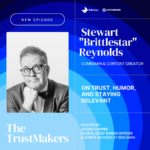By Jean-Christophe Peube, Equativ, EVP of Delivery Excellence
Remember when the Open Web was the scapegoat for all that failed the programmatic ecosystem? We can recite all the criticisms by heart. Unacceptable ad quality brought on by lack of fraud solutions and brand safety safeguards. Immense friction around digital ad viewability. The lack of early Open RTB standards not offering the caliber of granular data transparency and alignment on measurement that brand marketers need.
But then things got better. So much so that the Open Web is now positioned to be a foundational channel for brands to transact in a healthier manner.
A more rational and trustworthy marketplace began to emerge, helped along by the gradual attrition of many of the smaller, unscaled players that were not adding adequate value to justify the fees they were charging. Meanwhile, we also started to see standardization on many fronts, driven by increasingly scaled Open Web players like The Trade Desk and Criteo, pursuing a range of vertical integration strategies that drove consolidation, elevating contenders and weeding out the pretenders. Enlightened models like Programmatic Guaranteed within private, more curated marketplaces, began to emerge as well as industry-sanctioned tools like ads.txt and sellers.json being deployed to fuel an overall drive toward Supply Path Optimization (SPO).
All of this positive energy and development dovetailed with the massive headwinds blowing the walled gardens of Facebook and Google off course on both the antitrust and privacy fronts. Now that we are here, in 2023, the vulnerability of the Walled Gardens can no longer be dismissed as hyperbole.
This coalescing of unexpected trends now presents our industry with a new opportunity. As we all face the reality of a post-cookie/identifier world, it is important to recognize the rebalancing of the Open Web as a viable alternative to walled gardens for now and into the future. The nonsensical gap between walled garden share of ad spend (65%) higher than share of user time spent (30%) is in danger of being closed quite dramatically. For the better.
Brands have the opportunity to be the catalyst for a more equitable, balanced and ultimately more sustainable marketplace. By embracing a disciplined, thoughtful SPO strategy, along with a robust privacy strategy as we move closer to a post-PII paradigm, marketers can set themselves up for better performance across the entire marketing funnel.
While scaled, increasingly vertically integrated Open Web purveyors are emerging, it’s important to find a partner that takes a more comprehensive, sophisticated approach to SPO. First of all, make sure you choose a partner with exhaustive, always up-to-date sellers.json files and is open to providing SChain-Object-based reports. This partner should have direct connections to publishers, and offer products and features enabling you to be efficient (inventory packaging, contextual and privacy-compliant 3rd party data targeting, and secure 1st party data sharing aka clean rooms.)
Secondly, impeccable traceability is also a partner prerequisite. This includes domain transparency on both open auction and pre-packaged deals to optimize investments and implement these safeguards ahead of ad delivery.
Finally, the best partner will also ensure premium quality of inventory transacted on its platform. Certified tools with MRC accreditation to prevent most common threats (G-IVT, S-IVT, Brand Safety (GARM), Mis-/Disinformation, Clickbait/low user engagement properties). Having a partner that has this uncompromising level of accountability will have a cleansing effect on the entire value chain whereby everyone abides by the same high standard.
While it remains true that the Open Web remains a more complex environment in which to transact than within walled gardens, it offers many advantages that make it an attractive alternative. The Open Web operates with a much greater level of transparency and neutrality that promotes shared business value for all participants. The Open Web in 2023 has become a much more rational and efficient marketplace, both in terms of performance and cost. And with the major strides being made in SPO, it is easier to focus on a limited number of intermediaries, ones who only add value and help reduce the negative ad tech practices. And in so doing, the Open Web can be a vibrant conduit for consumer access to high-quality, reliable information, which the walled gardens have fallen far short in doing. This is good for democracy as independence of information and diversity in opinions can be better balanced on the Open Web.











